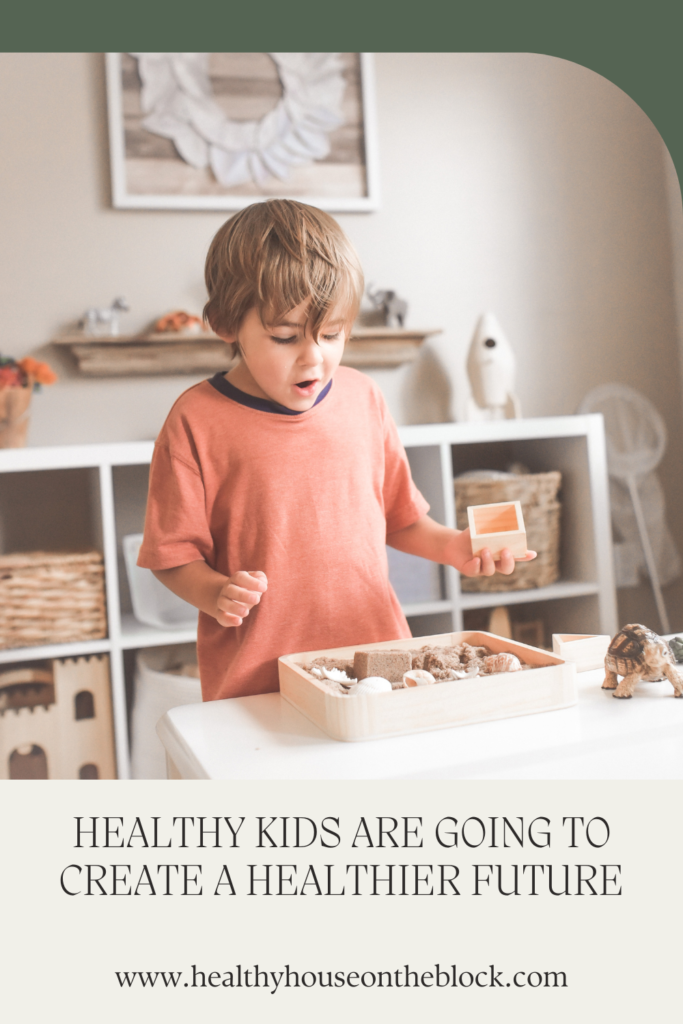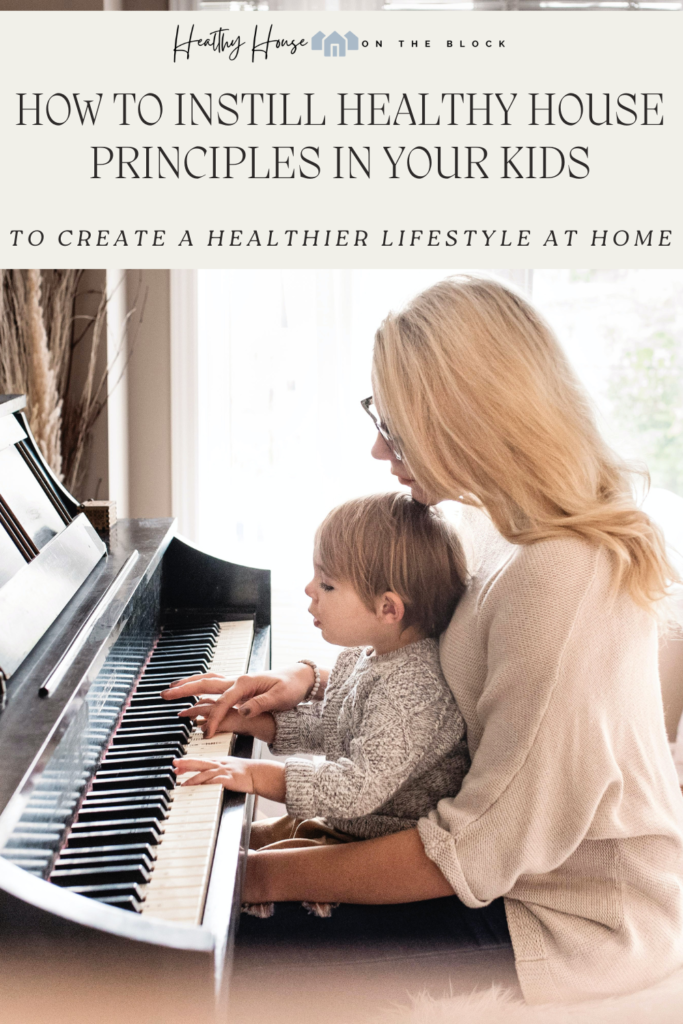
Raising healthy kids can be one touch job in the world we live in today. While it appears that there are so many positive, healthy practices around us, the truth is that many of us are at the mercy of our kids when it comes to changing lifestyle and habits in our home.
The goal really is to create a lifestyle and indoor space that promotes health and wellness. But at the same time, it’s also important to create a lifestyle and space that everyone enjoys.
And while kids are moldable and teachable in ways that adults may not be, they are also little humans who will stand their ground for what they want. In truth I think that it can become more difficult the older kids get because they see habits and items that other families have.
Of course it can be an AMAZING teaching opportunity to talk about why your family may reduce toxins in various ways, but it still doesn’t change the fact that kids may feel left out or ostracized because of those differences.
I know that I want my kids to be surrounded by as few toxins as possible, but that doesn’t mean I restrict them from anything with potential toxins. It means we reduce toxins wherever we can and sometimes we let small things be. Stressing my kids out over toxins is never my goal. I’m here to raise them, teach them and protect them, which is exactly what is covered here today.

KIDS ARE NOT MINIATURE ADULTS
As I mentioned before, kids are not just miniature adults. Our systems are fully developed and capable of filtering out toxins while protecting other organs from being affected. Children, on the other hand, have an undeveloped blood-brain barrier that allows many toxins to pass through before getting filtered out.
Children also have thinner and less dense skin and skeletal systems, meaning toxins can be absorbed at a more efficient rate in comparison to us as adults.
And if you have kids, you know that kids have much different hand-to-mouth habits in comparison to us as adults too. (Please tell me I’m not the only mom asking my kids to keep their hands off their faces and out of their mouths on a consistent basis?!) But it’s this habit that creates the perfect avenue for toxin exposure as they ingest toxic house dust more frequently than anyone else.

HOW THE HOME PLAYS A ROLE IN HEALTHY KIDS
Toxins inside that affect kids on a MUCH larger scale can be avoided sometimes, and so anywhere we can reduce them is going to make our home healthier and better for our family. Here’s a look at some of the big toxins that affect kids at home:
Flame Retardants: Flame retardants are added to textiles, mattresses, rugs and other components of kids room items. Flame retardants have been shown to increase the likelihood of aggression and defiance in kids (STUDY) as well as delay their neurological function, cognitive development and problem solving skills (STUDY).
Flame retardants have also been linked to weakened immune systems (STUDY) , thyroid and adrenal gland irregularities (STUDY) and problems with reproductive organs. (STUDY). On top of all these other issues, flame retardants are a known carcinogen and have been linked to an increased risk in thyroid cancer, the fastest increasing cancer in the US currently. (STUDY)
Phthalates: Phthalates are found in plastic and vinyl toys, plastic furniture, vinyl flooring, wallpaper and vinyl blinds. What we know is that often children’s exposure is well over the EPAs allotted “safe limit” of phthalates (STUDY). Phthalates have been linked to neurological toxicity in kids as well as have adverse impacts on neurodevelopment, including lower IQ, problems with attention and hyperactivity and poorer social communication. (STUDY)
Phthalates also disrupt the endocrine system and can cause issues with thyroid, immune function and the reproductive process. (STUDY)
Pesticides: Pesticides can be found in any sort of textile or fabric that you bring into your home as well as on your shoes. Pesticide exposure has been linked to increased risk of being diagnosed with ADHD (STUDY) as well as an increased risk of childhood cancer (STUDY).
Pesticides have also been shown to disrupt the body’s natural endocrine function and have potential to disrupt natural development in kids and babies. (STUDY)
Polyvinyl Chloride: Often times referred to as PVC, polyvinyl chloride is another material that is in SO many of our day to day items and materials. It can be found in strollers, car seats, window shades and frames, high chairs, carpet backing, mattress covers and most plastic or vinyl materials.
PVC has been linked to endocrine disruption that in turn plays a role in childhood obesity (STUDY). PVC toxins have also been linked to cancer (STUDY) and neurological toxicity in kids.

HEALTHY KIDS WILL CREATE A HEALTHIER FUTURE
One of the biggest reasons I want to instill a healthy lifestyle in my healthy kids is that THEY are creating our future. I don’t want my kids to grow up trying to correct habits that I’ve helped them create. I want my healthy kids to be able to have a healthy lifestyle from the start so as they grow there’s less they need to change when it comes to their environment. Ultimately THEY will be creating their own environments to surround themselves and some day their family.
In addition to not only just creating healthy habits, I want them to understand WHY we do things we do around our own home. I don’t want them to just trust every product is safe to use like I once thought. I want them to use their resources and find out WHY something is safe to use. That way as our researchers find out more information and know what even healthier options are, my healthy kids won’t have any problem changing their routine, products or habits, because they’ll have the WHY understood.

PRINCIPLES TO INSTILL FOR A HEALTHY LIFESTYLE AT HOME
Importance of products around our homes. If your kids are like mine, they may ask you non-stop questions of “why?”. I have come to embrace these questions and really explain to my girls the importance of why we use some things around the house in terms of products and why we avoid other products.
When I take them shopping with me, it’s a great time to verbalize the importance of WHICH products I’m choosing, and WHY I’m avoiding other products. I want my kids to understand these critical thinking parts of a healthy lifestyle instead of just grabbing whatever is cheapest or looks the prettiest.
Next time you’re making a purchase of a particular cleaning product, food, or home item, let your kids know WHY this is the choice your family has made and what the impact is on them as healthy kids.
Avoiding plastics in the kitchen. We are still in the process of removing a lot of plastic from our kitchen in terms of how I pack to-go lunches for the kids. I have been slowly trying to remove plastic snack bags and replace them with healthier options. We’ve done a great job so far, and we’ve got a little left to go.
When I started sending snacks in metal containers and silicone bags, I wondered if my kids would complain or worse, lose them at school. I was actually pleasantly surprised that my kids love taking snacks in fun little containers instead of bags and (knock on wood), we haven’t lost a container *yet*.
With this change it was a really great time to talk to the kids about why we were switching over, removing plastic dishes and using glass instead. Explaining to my girls WHY we do things and WHY some things are important to us as a family helps them get completely on board and know that these are healthy lifestyle components as they get older and make their own decisions.
Importance of the indoor air we breathe. This has been a really big hurdle, and sometimes I feel like I’m forever explaining why we don’t use air fresheners, candles or scented products around the house. If you have school-aged kids, they suddenly start to see what other families do and use and they start to question WHY their family doesn’t do the same thing.
I think it’s important to explain that not all healthy kids choose the same healthy lifestyle, and that’s okay. I like to explain to my kids that OUR family may not choose to do what another family does, but that’s okay — we can make our own choices in how to follow a healthy lifestyle at home.
I think it’s important not to pass judgment on how other families may be doing things in their home and just remind your kids that our goal is to create a healthy lifestyle within our own homes, not to worry about other families.
Reusing, using less and repairing what you have. In our fast-paced, one-time use, throw away culture, THIS can be a tricky one. We still work on it all the time with our girls, as their first instinct when something isn’t as new and shiny as it once was is to replace it with something new.
What has helped our family is pointing out examples and positive outcomes from repairing or reusing instead of buying new. One way we’ve successfully done this is through our craft table. A lot of their craft supplies have ended up being items we were either going to get rid of or throw away. The kids love getting creative with these things and finding new ways to use them.
I’m hoping just making this an important principle in everyday life will translate into their future of creating a healthy lifestyle at home by reusing what they already have.
Less is more. When we’re talking about instilling principles in our healthy kids, the important thing is to make sure that they are more about a healthy lifestyle and less about a short term goal. Creating a healthy environment at home often means bringing in fewer items in general. It can be a great way of teaching kids “less is more.”
And all kids are different in this regard. For example, my older daughter is a lover of tangible things and collects rocks, saves every card and note and has a hard time getting rid of items, whether they’re important to her or not. In contrast, my younger daughter has very little attachment to physical objects. She has a few special things she holds on to, but she’s willing to part with things when she’s done using them.
If you can show your healthy kids how you’re happily living with less and how freeing that feeling of a healthy lifestyle can be, you’ll help instill in them the idea that less stuff truly is a more full life.

TEACHING TACTICS FOR PARENTS OF HEALTHY KIDS
Include them in decisions. I think a great way to raise healthy kids and instill a healthy lifestyle in them for the long run is including them in decisions you make about products and habits as a family. As a family unit, you can talk about why some things are used in the house, and why some items are things we avoid. Talking to your kids about the underlying WHY you’ve chosen to make healthy decisions helps them use the same principles to make healthy lifestyle habits in their own life.
Soon enough our kids will be making more and more decisions about their own healthy lifestyle habits, eating habits and lifestyle choices. Letting them help make family decisions and give their opinion and letting them hear your “why” can be really great practice for the future.
Make it fun. All kids want to have fun! Making healthy lifestyle changes or habits fun for your healthy kids is a great way to make sure the habit sticks. Get them involved in the satisfaction of creating a clean, healthier home. Honestly, for kids it could be helping you mix up your toxin free cleaner, or helping you swap out plastic and donate it.
Kids see the beauty in everyday things that become mundane to us adults, so even the smallest things can be made fun. Last week we went on a family walk and brought with bags to pick up garbage off the side of the road — my kids thought this was SO fun.
Getting your kids involved in reusing things around the house can be a fun task for them too. Healthy kids are incredibly creative and sometimes I’m amazed at the ideas they have to contribute to our healthy lifestyle.
Lead by example. THIS x 100. Kids are little sponges and to be honest, they pick up more of our behaviors than our advice. I know my kids follow my example, and not necessarily my words. The more you pay attention to being intentional with purchase, creating healthy habits and making sure your home is a low toxin space, the more your healthy kids are going to notice the very present healthy lifestyle in your home.
I think this teaching tactic really boils down to being extremely intentional with so many areas of our life. Kids see when we’re mindlessly going through the motions and they also see when we’re thinking through decisions and talking out the reasoning behind some of our choices.
Create a family goal. Why not make your healthy lifestyle goal oriented? Maybe you have a goal of changing over all your bedding to organic bedding. Make it a goal for the whole family and create a chart to keep track. Or maybe it’s creating a goal of being active together as a family three times a week. Have a fun reward for every week you accomplish this. Maybe it’s a backyard fire pit night, or taking a trip to a local park or museum as a reward.
Make goals and get everyone involved in your family’s healthy lifestyle — especially when it comes to making changes and creating new habits.
Get involved in community opportunities. There are SO many opportunities to get you and your family involved in healthier habits. It could be getting involved in a local co-op or helping clean up parks and roads in your community.
When kids see other families like theirs, those that prioritize a healthy lifestyle, it helps solidify the healthy habits you’re teaching your healthy kids. You might even invite friends or family to join you in a fun community activity you find. Having friends get involved makes it more fun for kids, and who knows, maybe your friends will see your healthy lifestyle changes and start their own.
This last winter, our neighbors invited us to pack up baby supplies and diapers for new mothers in need and we decided to make it a yearly event. The kids had so much fun with their friends, and we all really loved being involved and doing something positive together.
Let them be a part of the discussions around healthy habits and living. Having discussions about creating a healthy lifestyle in front of your kids can be extremely powerful. Kids pick up on things, and so having these conversations in front of them instead of after they’re asleep or while they’re playing in another room can help instill these ideas and lifelong habits in them.
You can even ask your kids questions or opinions and really get them involved in the conversation.

Healthy kids grow to be healthy adults when the principles and ideas are instilled as a lifestyle, and not just a temporary habit or change.



